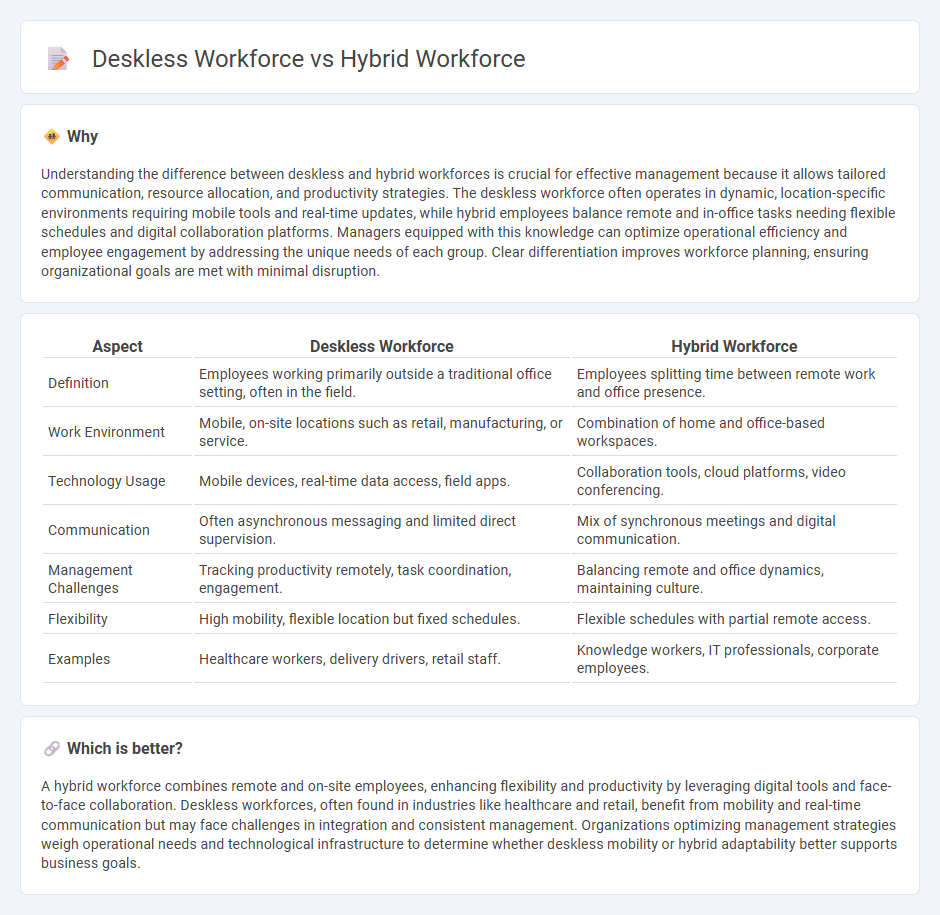
Management strategies for deskless workforce focus on mobile communication, real-time task tracking, and flexible shift scheduling to enhance productivity in dynamic, on-the-move environments. Hybrid workforce management integrates remote and in-office employee coordination, leveraging digital collaboration tools and adaptive policies to maintain engagement and performance. Discover comprehensive approaches to optimize both deskless and hybrid workforce management models for your organization.
Why it is important
Understanding the difference between deskless and hybrid workforces is crucial for effective management because it allows tailored communication, resource allocation, and productivity strategies. The deskless workforce often operates in dynamic, location-specific environments requiring mobile tools and real-time updates, while hybrid employees balance remote and in-office tasks needing flexible schedules and digital collaboration platforms. Managers equipped with this knowledge can optimize operational efficiency and employee engagement by addressing the unique needs of each group. Clear differentiation improves workforce planning, ensuring organizational goals are met with minimal disruption.
Comparison Table
| Aspect | Deskless Workforce | Hybrid Workforce |
|---|---|---|
| Definition | Employees working primarily outside a traditional office setting, often in the field. | Employees splitting time between remote work and office presence. |
| Work Environment | Mobile, on-site locations such as retail, manufacturing, or service. | Combination of home and office-based workspaces. |
| Technology Usage | Mobile devices, real-time data access, field apps. | Collaboration tools, cloud platforms, video conferencing. |
| Communication | Often asynchronous messaging and limited direct supervision. | Mix of synchronous meetings and digital communication. |
| Management Challenges | Tracking productivity remotely, task coordination, engagement. | Balancing remote and office dynamics, maintaining culture. |
| Flexibility | High mobility, flexible location but fixed schedules. | Flexible schedules with partial remote access. |
| Examples | Healthcare workers, delivery drivers, retail staff. | Knowledge workers, IT professionals, corporate employees. |
Which is better?
A hybrid workforce combines remote and on-site employees, enhancing flexibility and productivity by leveraging digital tools and face-to-face collaboration. Deskless workforces, often found in industries like healthcare and retail, benefit from mobility and real-time communication but may face challenges in integration and consistent management. Organizations optimizing management strategies weigh operational needs and technological infrastructure to determine whether deskless mobility or hybrid adaptability better supports business goals.
Connection
Deskless workforce and hybrid workforce models intersect through their reliance on flexible work arrangements and mobile technology to enhance productivity. Organizations implement cloud-based platforms and real-time communication tools to manage both on-site deskless employees and remote hybrid workers efficiently. This integration supports seamless collaboration, improves operational agility, and drives better workforce engagement across diverse work settings.
Key Terms
Flexibility
The hybrid workforce combines remote and on-site work, enhancing flexibility by allowing employees to choose where they work based on tasks and preferences, boosting productivity and job satisfaction. The deskless workforce, primarily mobile or frontline workers without assigned desks, requires flexible scheduling and real-time communication tools to adapt to dynamic work environments that often involve field operations or customer interactions. Explore the key strategies and technologies that optimize flexibility for both workforce models.
Technology Enablement
Technology enablement in hybrid workforces leverages cloud platforms, collaboration tools, and AI-driven productivity apps to seamlessly connect remote and in-office employees, enhancing flexibility and efficiency. Deskless workforces utilize mobile devices, IoT sensors, and real-time communication apps to streamline operations and provide instant access to critical information on the go. Explore innovative technology solutions tailored to empower both hybrid and deskless teams for optimized performance.
Employee Engagement
A hybrid workforce combines remote and on-site employees, requiring tailored engagement strategies that address the flexibility and collaboration needs of both groups. Deskless workers, often mobile or frontline staff without fixed workstations, demand engagement approaches centered on real-time communication and mobile accessibility. Explore effective methods to boost employee engagement in hybrid and deskless environments.
Source and External Links
What is a hybrid workforce? - ServiceNow - A hybrid workforce combines in-office and remote work, giving employees more autonomy over where they work to balance flexibility with the benefits of in-person collaboration.
What is a Hybrid Workforce? Meaning, Benefits & the Future of Work - Hybrid workforces blend remote and in-office work in flexible arrangements that can range from primarily in-office, primarily remote, to evenly split schedules, depending on employee and business needs.
What Is a Hybrid Workforce? Meaning & Best Practices - Simpplr - A hybrid workforce allows some or all employees to choose between working on-site, remotely, or a mix of both, supporting flexibility and improved work-life balance.
 dowidth.com
dowidth.com